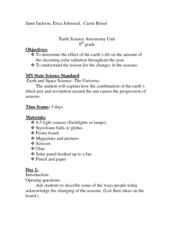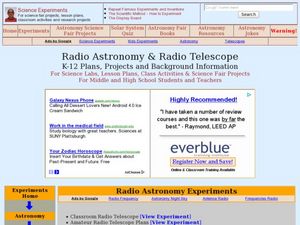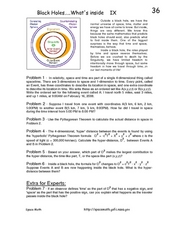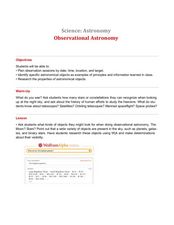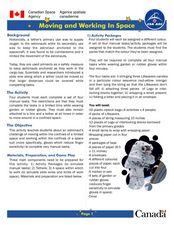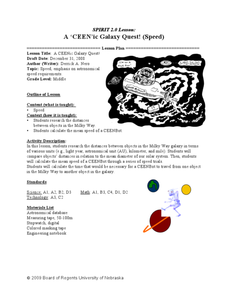Curated OER
Egypt's golden Empire
Students explore many of the key scientific and technological contributions made by the ancient Egyptians. Researched data is presented to the entire group.
Curated OER
SUNSPOTS SPOTTED
Students study sunspots and their motion, from data gathered, they determine the significance of the sunspot data. The data be used to calculate the rotational period of the sun. They draw conclusions as to the sunspot's impact on the...
Curated OER
Why Do We Have Night?
Young scholars engage in a fun, creative way to discover how the Earth moves. This lesson helps students explain why there is day and night. It can also create curiosity to further study the solar system and eclipses!
Curated OER
A Tour of Saturn and Uranus
Second graders draw and label each planet, Saturn and Uranus, showing 2 specific individual characteristics of each.
Curated OER
Stellar Discoveries That Are Out of This World
Students hear of the recent discovery of a group of planets orbiting the star Upsilon Andromedae. Each student create a page about an element of the universe,
Curated OER
Biography of a Star: Our Sun's Birth, Life, and Death
Students examine how astronomers use parallax to determine the distances of stars in the Sun's neighborhood. They construct a pinhole protractor, and measure angles and calculate distances.
Curated OER
Picture an Astronomer
Students create a drawing of what an astronomer looks like. They explore their own assumptions of those who work in the sciences.
Curated OER
Space Shuttle Mission STS-128
In this space science worksheet, students read about the space shuttle mission and answer 6 short answer questions about life of astronauts in space stations.
Curated OER
Why is There a Tidal Bulge Opposite the Moon?
Students simulate how the Moon causes ocean tides. In this earth science lesson, students calculate gravitational acceleration using a mathematical formula. They compare the force of attraction between the Earth, Moon and Sun system.
Curated OER
Constellations
Fifth graders create their own constellations using pin holes and black paper. In this space science lesson, 5th graders write a story about their constellation. They share their project with the class.
Curated OER
Distance Makes a Difference
Middle schoolers create a clay model of the Sun and Earth. In this space science lesson plan, students explain how distance affects the appearance of objects. They write a poem or riddle about the Sun in their journal.
Curated OER
Earth Science Astronomy Unit: Seasons on Earth
Eighth graders describe how the Earth's position causes seasonal changes. In this astronomy lesson, 8th graders explain how solar radiation varies depending on the season. They create a collage or poster on each of the Earth's four seasons.
Curated OER
The Moon
Learners design and build an ideal lunar settlement. In this astronomy instructional activity, students identify the key features of the moon. They compare its environmental condition with the Earth's.
Curated OER
Solar System Bead Distance Activity
Students create a scaled solar system model using colorful beads. For this space science lesson, students convert AU units into metric measurements. They arrange the planets according to their distances from the sun.
Curated OER
Black Holes
Students explore what black holes are and how gravity is associated with them. In this space activity students are given enough information to imagine a journey to a black hole.
Curated OER
Radio Astronomy and Radio Telescope
Students construct a simple radio telescope. In this astronomy lesson plan, students explain how this telescope works and what information it collects.
Curated OER
Black Holes... What's inside IX
In this space science worksheet, students solve 7 problems related to black hole space and time. They answer questions related to the spacetime dimension.
Curated OER
Observational Astronomy
Students research about the characteristics of celestial bodies using a database. In this space science lesson, students collect data such as brightness, apparent color and size by observing the night sky. They share their findings with...
Curated OER
Moving and Working in Space
Students complete four tasks with certain restrictions. In this astronomy lesson, students explore different ways that astronauts can anchor and maneuver in space. They recognize the challenges they face from day to day.
Curated OER
Seasonal CEENBoT
Students simulate the Earth's revolution around the sun using CEENBoT. In this earth science instructional activity students calculate the Earth's distance in AU and it's speed of revolution. They explain how the Earth's movement cause...
Curated OER
Planetary Terrain
Young scholars research the unique features of their assigned planet. In this astronomy lesson, students organize their findings and present it to class. They recreate planetary terrain and use CEENBoT to drive over it.
Curated OER
A CEENic Galaxy Quest!
Students research the distances between objects in the Milky Way. In this astronomy lesson, students calculate the time it would take for a robot to travel from Milky Way object to another. They create a travel package for customers...
Curated OER
The Next Logical Step in Astronomy
Young scholars research future astronomy endeavors and how the exploration with contribute to astronomy and humanity. In this astronomy lesson plan, students research, present, and debate the topics as a class.
Curated OER
Tracking and Tracing Sunspots
Students examine sunspots. In this sunspot lesson, students use applets to investigate the movement of sunspots. Students research sunspots and evaluate the rotation of the sun. Lesson references outside resources not available in this...













